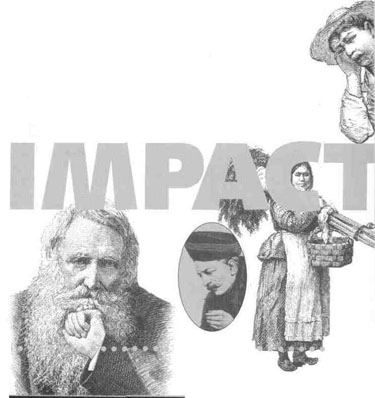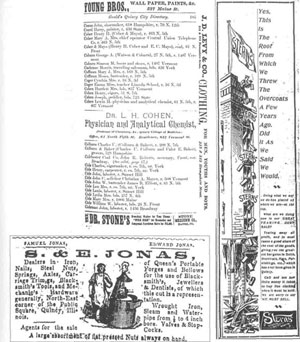 |
Home | Search | Browse | About IPO | Staff | Links |
 |
Home | Search | Browse | About IPO | Staff | Links |
Howard Rubin
Overview
Main Ideas
In the 1840s the small Mississippi River town of Quincy sat at the edge of the American frontier. A small Jewish community in Quincy grew and developed to become a religious and cultural bastion of Judaism as well as a foundation to many of the social, political, and economic institutions of the community at large. The story of the Jewish population of Quincy is a classic immigrant success story, but it is also unique because of the degree of acceptance of Jews and their impact on Quincy. Certainly life would have been different had their immigration led to a larger urban center. The Jewish population of Quincy took an active involvement in all aspects of daily life. At the same time Jews nurtured a community within a community based on religious beliefs and custom. In 1871 this commitment to religion led to the construction of a synagogue, B'nai Sholom, which is open today. The rise and decline of the Jewish community parallels Quincy as a viable river town. As the frontier passed and the railroad supplanted the Mississippi River as a transporation route, opportunity in Quincy began to shrink. Older established families, as well as young people, moved as they sought new opportunities and new frontiers. It is important to note that the Jewish community may have had an atypical experience in Quincy.
Connection with the Curriculum
Teaching Level
Materials for Each Student
• A copy of the narrative portion of the article
Objectives for Each Student
• Identify and explain the unique role of the immigrant Jewish population of Quincy that created the conditions for their integration into the community at large.
Opening the Lesson
• Have students read the narrative portion of the article in advance.
Developing the Lesson
34 be used more than once, but encourage students to explain why or how it may connect to another item or category. Brief discussions between group members as to the placement of an item leads to a deeper development of understanding of the concept and allows students to demonstrate their understanding verbally and visually. Second, each group (or individual) needs to look at its list and assign a rank to the items it believes may have had the greatest impact. Teacher prompting from group to group is important throughout the lesson. • Activity 2 is a primary source activity that may also be done as a jigsaw group activity. Assign groups of three students. Allow each group member to select one section, A, B, or C, to complete. Students will use the information from each part to answer the concluding section as a group. Students will read and interpret brief citations from two newspapers, the Quincy Daily Herald and the Israelite, as well as a few advertisements from Jewish-owned businesses. Encourage students to critically read, examine, and discuss each passage. The Israelite passage speaks to the economic and religious involvement of the immigrant Jews. The Rabbi is cautious about the strained relations between Jewish businessmen. The Daily Herald article demonstrates the depth of social involvement within the Quincy community. Jews and gentiles socialized, perhaps to a larger degree in Quincy than in urban areas. The "Bal Masque" was the Jewish festival of Purim, and because the Jews were small in number, the entire community was invited to participate. The various advertisements represent the diversity and great involvement of Jewish-owned businesses in Quincy's economic life. • Activity 3 is a primary source activity that requires students to take a retrospective approach to the rise and decline of Quincy. Students will read the introduction to a 1895 article from the Quincy Daily Herald. They are then asked to consider the history and the role of the Jewish community in Quincy and what the future may bring.
Concluding the Lesson
Extending the Lesson
• Ask students to debate the pros and cons of immigration to small towns and large urban areas. • Visit a local or regional historical society to discover the contributions and impact of immigrants on the town. • Invite a guest speaker and conduct a class interview. Have students write questions and submit them to the guest speaker in advance.
Assessing the Lesson

35
Directions: After reading the narrative about the experiences of the Jewish community in Quincy, look over the list of terms below.
After each category list is complete, in the opinion of your group, rank the top two items in each category by placing a 1 or 2 to its left. Be able to explain why. As a group, answer the following questions with as much detail as you can. What conclusions can one make concerning the impact of the Jewish community on the various institutions in Quincy? Why was this important for the immigrant Jewish population? Why was this important for Quincy?
36
37

38

Upper left: Gould's City Directory, 1884-1885; lower left: Everhart's Quincy City Directory for 1855-56, p. 106; right: Quincy Daily Journal, December 17,1895.
Part C—Advertisements
Give an example.
39
Part D—Group Conclusions for Class Discussions. After answering the questions from the sections above, what generalizations can your group make concerning the impact of the Jewish community on the town of Quincy?
40
41
|
|
|